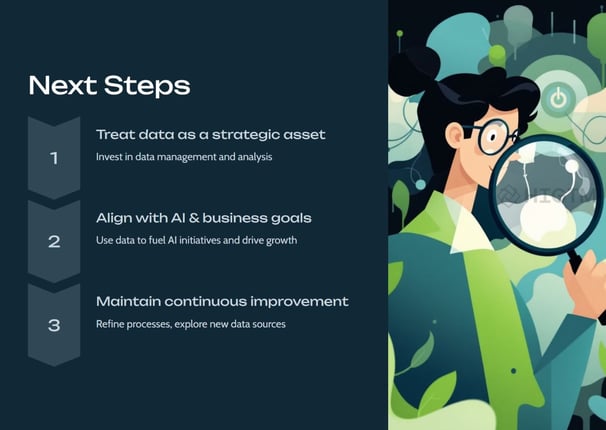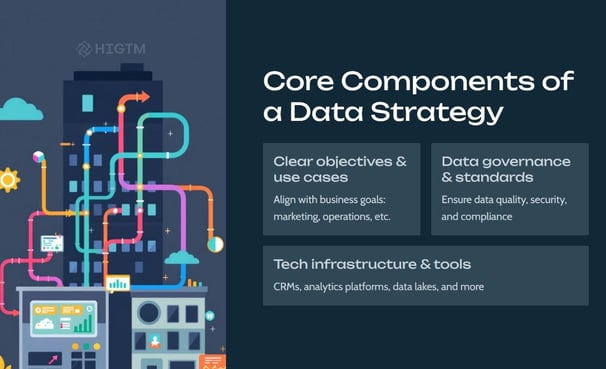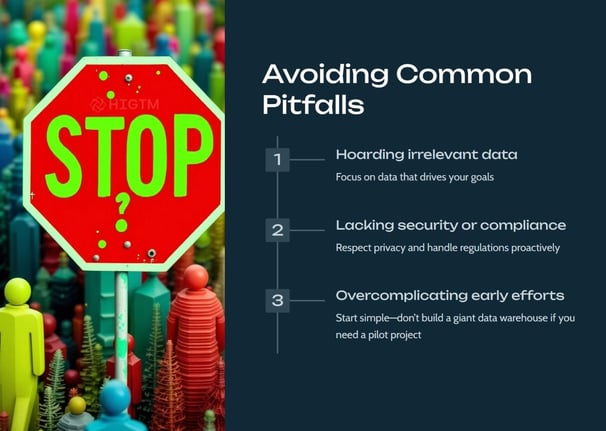32. Data as the New Currency – Why Data Strategy Matters
Businesses run on data—transactions, customer interactions, supply chain records, and more. For small and medium-sized enterprises, data can feel overwhelming or scattered. Yet it’s a pivotal asset, shaping AI, personalization, and operational insights. This article delves into why data is considered the new currency, the pitfalls of ignoring data strategy, and practical steps for SMEs aiming to maximize value from their information.
Q1: FOUNDATIONS OF AI IN SME MANAGEMENT - CHAPTER 2 (DAYS 32–59): DATA & TECH READINESS
Gary Stoyanov PhD
2/1/20255 min read

1. The Rise of Data as Currency
1.1 Data’s Untapped Potential
Financial analysts once viewed intangible assets—like brand reputation—as hidden gold. Now, data holds that spotlight. Properly harvested, structured, and analyzed, data can transform how your business operates, from simple cost savings to advanced revenue streams.
1.2 Tangible Gains for SMEs
Large corporations exploit data to hone marketing campaigns or fine-tune product lines. Smaller companies can adopt similar data strategies in scaled-down ways—like analyzing local demographics to adjust store inventory, or using e-commerce analytics to tailor email campaigns.
1.3 Comparisons to Traditional Currency
Like money, data has value when stored properly and used wisely. Poor management leads to waste, compliance headaches, or missed revenue. Good data practices, akin to safe banking, ensure you extract meaningful ROI from it.
2. Why a Data Strategy Is Essential
2.1 Aligns Data Collection with Goals
A strategy defines how data supports specific business targets. For example, if your aim is to reduce product returns, track reasons for returns meticulously. If you want to expand digital marketing, gather leads from multiple channels and unify them in a central system.
2.2 Encourages Accountability
Each piece of data has an “owner” who keeps it updated and ensures quality. Without these roles spelled out, confusion arises—leading to outdated or contradictory records across departments.
2.3 Builds Trust Internally
A well-structured data approach fosters transparency. Colleagues know where to find reliable information, which dashboards reveal up-to-date stats, and how to escalate corrections if they spot errors.
3. Key Components of a Strong Data Strategy
3.1 Clear Objectives
Decide which business challenges you want data to solve. Are you optimizing supply chains, personalizing customer outreach, or driving new AI pilots?
3.2 Data Governance
Governance sets rules for data access, security measures, and usage guidelines. It answers who sees what data, how frequently systems refresh, and which compliance standards apply.
3.3 Infrastructure Choices
Data warehouses, lakes, or hybrid models serve as the backbone. Tools like relational databases (for structured records) or data lakes (for unstructured logs) each have pros and cons. SMEs might start with modest storage solutions integrated with cloud analytics.
3.4 Ongoing Management & Maintenance
Data flows evolve as your business grows. Regular audits or refresh cycles keep everything relevant. If product lines expand, your data structures must adapt to hold new categories or SKUs.
4. Step-by-Step Guide to Building a Data Strategy
Map Data Sources
Inventory all the places data originates, from website logs to in-store transactions.
Note the type (structured, unstructured) and frequency (real-time, daily batch).
Define Data Ownership
Assign roles: a marketing manager might “own” leads from campaigns, while a warehouse supervisor “owns” inventory data.
Specify each owner’s responsibilities—such as cleaning or updating records.
Set Governance & Security
Draft guidelines for who can view or edit data.
Implement encryption or password protocols, especially if personal details or payment info are collected.
Establish Tech Infrastructure
Choose user-friendly tools: some SMEs thrive on basic spreadsheets integrated into a small data warehouse; others adopt specialized cloud platforms for advanced analytics.
Plan for Scalability
Expect data volume to increase if AI or e-commerce expansions unfold.
Decide whether you’ll keep everything on-prem or use a cloud-based system to handle peaks.
Track KPIs & Evolve
Monitor if your data approach helps reduce errors or speeds up analytics.
Update policies as your store or service lines evolve.
5. Avoiding Common Pitfalls
5.1 Hoarding Data Without Purpose
Collecting every possible metric, with no plan to use or validate it, leads to data bloat. This can also raise security or compliance concerns. Instead, focus on data aligned with your AI or strategic goals.
5.2 Overcomplicating Early Efforts
A small business typically needs a more straightforward system. Diving into advanced big data platforms without the staff or budget to sustain them often leads to abandoned projects.
5.3 Ignoring Compliance
Regulations like GDPR or CCPA require transparency about how user data is used. If you overlook these requirements, you risk fines or legal trouble—especially once you scale up.
5.4 Neglecting Team Training
Users who rely on data must learn how it’s structured, how to query it, and how to flag inaccuracies. A data strategy fails when staff misunderstand systems or remain unwilling to adopt new processes.
6. Integrating Data Strategy with AI
6.1 Foundation for AI Pilots
No model works well on broken or outdated data. Building a robust data layer (with accurate, well-documented records) underpins AI projects. Many AI fiascos stem from poor data quality, not faulty algorithms.
6.2 Empowering Personalization & Analytics
Recommendation engines, predictive maintenance, or advanced analytics rely on consistent user attributes, product tags, or event logs. A data strategy ensures your AI sees the right information.
6.3 Maintaining Model Performance
As you expand AI usage, new data emerges daily. Proper pipelines refresh model inputs regularly, preventing drift and ensuring that predictions or recommendations stay accurate.
7. Real-World Examples
7.1 Retailer Unifying Sales & Inventory
A clothing boutique integrated point-of-sale data from physical shops with its e-commerce logs, creating a single data hub. This synergy allowed them to forecast inventory more accurately, reducing stockouts and optimizing reorder points.
7.2 Manufacturer Tracking Sensor Data
A small parts factory installed IoT sensors on machines for predictive maintenance. Establishing a structured data pipeline—tagging sensors, scheduling updates—gave them timely insights that slashed downtime.
7.3 Service Provider Refining Client Profiles
A local marketing agency merged CRM data, email campaign results, and event attendance logs. This consolidation let them spot which clients engaged most, targeting them for premium offerings.
8. Strategies for Scaling Data
8.1 Modular Architecture
Begin with smaller, well-defined data sets. If you later need big data capabilities, add modules or upgrade. Avoid implementing the entire system at once.
8.2 Cloud Approaches
Cloud platforms offer pay-as-you-go services, letting you scale storage and compute power. This approach suits SMEs anticipating growth but wary of large upfront investments in on-prem servers.
8.3 Hybrid Systems
Some keep sensitive data on local servers while pushing less critical logs to the cloud for analytics. This arrangement can balance security or compliance with on-demand analytics tools.
9. Building a Data Culture
9.1 Encouraging Openness & Collaboration
Teams often hoard data. A good culture promotes sharing so marketing, finance, or operations can glean insights from shared pools. Transparent dashboards help everyone stay on the same page.
9.2 Regular Check-Ins
Monthly or quarterly data reviews let key people spot anomalies or inefficiencies, like outdated fields or an incomplete product listing.
9.3 Recognizing Achievements
When employees use data-driven findings to optimize a process or discover a new market segment, celebrate those wins. This behavior fosters continued engagement.
10. Moving Forward: Data as a Strategic Advantage
10.1 Linking to Business Goals
Always keep strategic aims in mind—be it launching an AI pilot, personalizing customer experiences, or just streamlining internal workflows.
10.2 Seeking Expert Input
If your data complexities expand, consultants specializing in data architecture or governance can fill knowledge gaps. Or you can hire specialized roles, such as a data engineer or data governance lead, if the demands warrant it.
10.3 Continuous Improvement Loop
Your data strategy shouldn’t be static. Revisit policies as your SME grows or attempts new AI experiments. Each success or setback teaches you how to refine your approach.
A well-structured data strategy stops chaos, letting you unify sources, maintain quality, and comply with regulations. With simpler steps—like mapping data flows, clarifying ownership, and picking scalable tools—you’ll build a foundation suitable for advanced AI projects down the line.






Turn AI into ROI — Win Faster with HIGTM.
Consult with us to discuss how to manage and grow your business operations with AI.
© 2025 HIGTM. All rights reserved.
